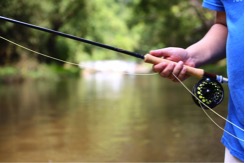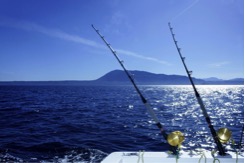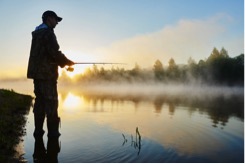All types of fishing are fun and offer a great opportunity to spend quality time with your family and friends in the outdoors. Learn more about freshwater fishing, saltwater fishing, fly fishing and ice fishing here. Choose the type of fishing that you want to do when you take your next trip.
Ice Fishing
If you like spending time outdoors in the northern states during the winter months, then ice fishing is one of the types of fishing you should learn more about.

Ice fishing provides anglers an opportunity to go fishing during the colder months of the year. A unique experience, ice fishing can offer anglers a chance to fish almost any spot of a lake or river without a boat. It can also offer individuals a chance to get outside, breathe in the winter air and enjoy time with family and friends.
Ice fishing is concentrated in certain areas of the country where the weather permits ice to thicken enough for walking, but that does not mean the activity is limited to those who live in those areas. It requires different tools and techniques than fresh or salt water fishing. Once you have been on the ice and tried the sport, you may find you like ice fishing just as much, maybe more, than other types of fishing.
This type of fishing involves the use of an ice auger to drill holes into the ice on a frozen lake, pond or river and then catching fish on hooks and lines through the openings in the ice. To help provide protection from the wind and cold, anglers often fish inside of ice shanties or portable shelters.
Fly Fishing
Fly fishing involves the use of artificial flies to catch fish in either fresh or saltwater. The fly is cast into the water using specialized gear, which includes a fly rod, reel, and weighted line. We will take a look at the basics.

To start fly fishing you need a fly rod, a line and some artificial flies. The idea is to catch fish by getting them to bite on an imitation of a bug or bait fish on, or just below, the water. Flies are made using thread, wire, beads, feathers, yarn and hair, and are created to look like insects and bait fish at various stages of maturity to attract trout, salmon, pan fish and carp, as well as marine species such as tarpon, bone fish and striped bass.
Most people think of fly fishing as a sport best enjoyed in mountain streams with catches of trout and salmon. Though these types of waters are great places to fly fish, you can also enjoy amazing fly fishing in the warm waters of ponds and lakes, and in salt water - and catch a broad array of fish. There's probably a body of water you can use for fly fishing not too far from where you live.
Fly fishing involves the use of artificial flies to catch fish in either fresh or saltwater. The fly is cast into the water using specialized gear, which includes a fly rod, reel, and weighted line. This method of fishing uses techniques that are more challenging than other types of fishing since it involves casting a very light-weight fly instead of a heavier lure or natural bait. Fly fishing techniques and gear will vary depending on the habitat.
Saltwater Fishing
Due to the various different types of saltwater fish and number of fishing techniques that can be applied, saltwater fishing is a welcome challenge for seasoned and beginner anglers.

Beginners can choose to target species such as spotted seatrout and redfish from shore or from a shallow water flats boat, while experienced big game anglers may prefer to spend time saltwater deep sea fishing for offshore species like marlin or tuna from a large sportfishing boat. The type of fishing tackle and gear that is used for saltwater fishing differs considerably based on the species and the specific fishing techniques that are applied.
Saltwater fishing is as much about the adventure as it is about the fish. Many of the sport fish species can be big and mean, and the water can be big and bad. From shallow saltwater flats to deep-ocean fishing, saltwater anglers chase everything from dainty speckled trout to massive blue marlin in some of the most intense and inspirational surroundings on earth.
Saltwater fishing can be as simple or as complex as you wish. Beginners can start fishing from the beach with basic tackle and a handful of saltwater rigs. Then continue to hone your skills and try more advanced saltwater fishing with the help of our saltwater fishing tips and tricks. Soon you could be an avid angler who spends endless time offshore catching prized sportfish.
Whether you live along the 10,000 miles of U.S. coastline or are visiting the ocean for the weekend, there are plenty of opportunities to wet a line. And plenty of fish in the sea.
Freshwater Fishing
Freshwater fishing means fishing in waters that are generally considered to contain fresh water, with minimal or no salt content. It’s one of the more versatile types of fishing, with various species of fish, and many ways to fish for them.

There are freshwater lakes, reservoirs, ponds, streams and rivers in every state across the country that are included in the list of the best places to fish . Freshwater fishing is one of the types of fishing that is ideal for beginning anglers since it can be enjoyed from shore or from land using a simple tackle set up. There are many types of freshwater fish, such as largemouth bass or bluegill, which can be targeted by the entire family with a basic rod and reel combo. About 40 percent of all fish are freshwater species . Common freshwater fish species are bass, trout, certain species of salmon, walleye, musky, crappie, catfish, and many others.
Freshwater fishing can be done in manys-from shore or a boat, from a bridge or dock, in lakes and ponds, and rivers and streams. There are a variety of freshwater fishing techniques, in addition to gear , baits and lures, depending on the type of fish you’re after.
With all the different possibilities, there’s something for everyone. What are you waiting for?

